 To enhance service speed and avoid tariff delays, we've opened a US warehouse. All US orders ship directly from our US facility.
To enhance service speed and avoid tariff delays, we've opened a US warehouse. All US orders ship directly from our US facility.
| Cat. No. | Product Name | Field of Application | Chemical Structure |
|---|---|---|---|
| DC49907 | 5A2-SC8 Featured |
5A2-SC8 is a dendrimer for miRNA delivery to late-stage liver tumors with low hepatotoxicity. 5A2-SC8 shows potent EC50 < 0.02 mg/kg (siRNA against FVII (siFVII)) in dose-response experiments, and well tolerated in separate toxicity studies in chronically ill mice bearing MYC-driven tumors. 5A2-SC8 is a degradable lipid-like compound (ester-based dendrimer) for small RNAs delivery.5A2-SC8, was obtained by screening a large library of more than 1500 ester-based dendrimers
containing ionizable amino groups, which have three
tertiary amine heads and five lipid tails. Based on this library,
the in vitro transfection efficiency of different formulations of
5A2-SC8 iLNPs was evaluated, discovering the optimal formulation
(5A2-SC8, DOPE, cholesterol, PEG at a molar ratio of
15:15:30:3) of 5A2-SC8 iLNPs for delivering fumarylacetoacetate
hydrolase (FAH) mRNA to liver.After the intravenous injection
via tail, the model mice of hepatorenal tyrosinemia type I
had strong FAH protein expression, which prevented
body weight loss and increased the survival rate of hepatorenal
tyrosinemia mice . In addition to introducing utility of
5A2-SC8 iLNPs for the therapeutic intervention, the 5A2-SC8
iLNPs containing DOTAP have been used to establish complex
mouse models via intravenous injection, including in situ liverspecific
cancer model and in situ lung-specific cancer model.
Based on this iLNPs delivery system, 5A2-SC8 induced model
construction method overcomes the time-consuming and costly
disadvantages of traditional animal models establishing methods,
including transgenesis and gene engineering in embryonic
stem cells.
More description
|
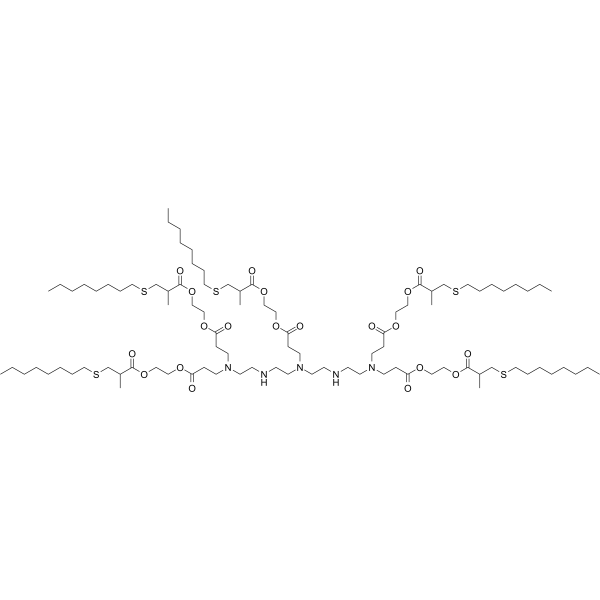
|
| DC70010 | 98N12-5 Featured |
98N12-5 is an ionizable cationic lipid. It has been used in combination with other lipids in the generation of lipid nanoparticles (LNPs). LNPs containing 98N12-5 and encapsulating proprotein convertase subtilisin kexin type 9 (PCSK9) siRNA selectively accumulate in the liver and reduce total serum cholesterol levels in mice and rats and serum LDL levels in cynomolgus monkeys.
More description
|

|
| DC12381 | DLin-KC2-DMA Featured |
DLin-KC2-DMA is a highly potent ionizable lipid used in the formulation of lipid nanoparticles (LNPs) for the delivery of siRNA. It represents a significant advancement over earlier generations of lipids, such as DLin-DMA, due to its dramatically improved gene silencing efficiency.
More description
|
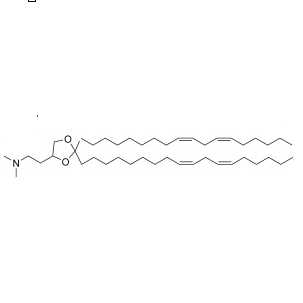
|
| DC49257 | DLin-K-C3-DMA Featured |
DLin-KC3-DMA, a nucleic acid, shows in vivo silencing activity. DLin-K-C3-DMA can be used in the synthesis of nucleic acid-lipid particle to delivery of nucleic acid.
More description
|
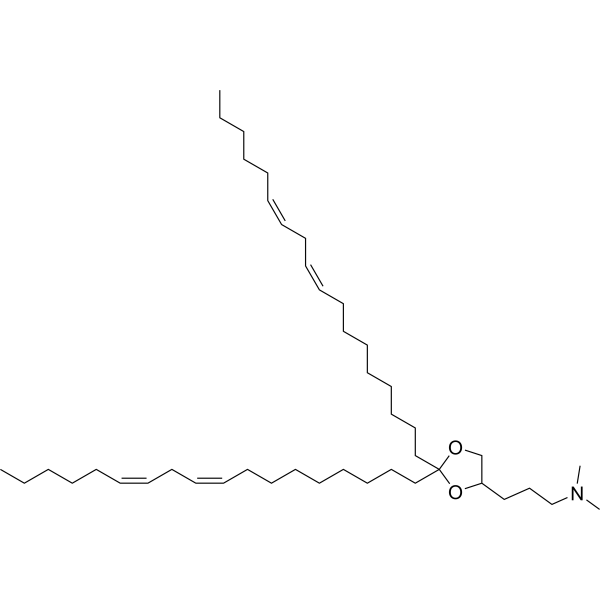
|
| DC49889 | 503O13 Featured |
503O13 is a next-generation, biodegradable lipid nanoparticle (LNP) engineered for highly efficient and targeted siRNA delivery. Designed through rational structure-activity criteria—including optimal tail length (O13), tertiary amines, and a surface pKa ≥5.5—this single-component LNP achieves unparalleled gene silencing with an ultra-low EC50 of 0.01 mg/kg in preclinical models.503O13 outperforms non-degradable counterparts (e.g., C12-200) with improved toxicity profiles—no hepatic necrosis or pancreatic inflammation—while maintaining rapid blood clearance (t1/2: 6 min) and organ-specific accumulation (liver/spleen).
More description
|

|
| DC65701 | L-369 Featured |
L-369 (Lipid 369,L369) is novel class of ionizable lipid for siRNA delivery with improved in vivo elimination profile with excellent translation across species,including NHP, wide safety margin.
More description
|

|
| DC80066 | 306Oi10 Featured |
306Oi10 is a branched-chain ionizable lipidoid that has shown significant promise in the generation of lipid nanoparticles (LNPs) for mRNA delivery. Its unique structural and functional properties make it a highly efficient delivery vehicle for mRNA-based therapeutics.
More description
|
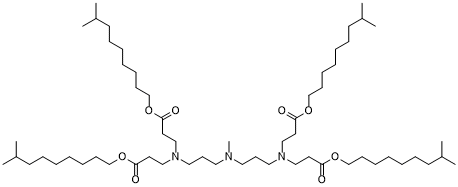
|
| DC57002 | LIPID C24 Featured |
C24 is a novel multiprotic ionizable lipid. C24 lipid nanoparticle (LNP) has a multistage protonation behavior resulting in greater endosomal protonation and greater translation compared to the standard reference MC3 LNP. C24 LNP also lower injection site inflammation and higher stability compared to MC3 LNP.
More description
|
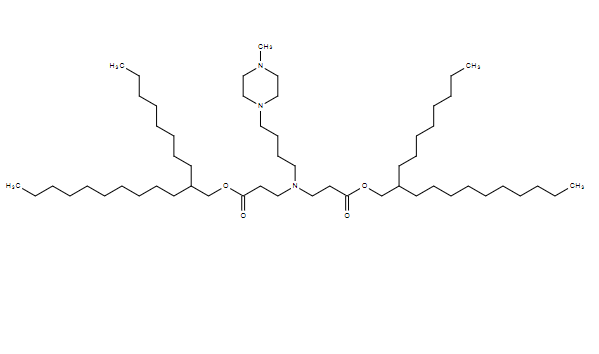
|
| DC49952 | 246C10 Featured |
246C10 is a synthesized ionizable lipid. 246C10 can be formulated into lipid nanoparticles (LNPs) with dioleoylphosphatidylethanolamine (DOPE), cholesterol, and C16-PEG2000 ceramide (PEG-lipid) as well as mRNA. The lipid nanoparticle formulations can be used for mRNA delivery. To obtain iLNPs that could specifically target liver sinusoidal
endothelial cells (LSECs), six different ionizable lipids (241C10
to 246C10) were synthesized by an epoxide ring-opening
reaction with piperazine- or piperidine-containing amines.
Biodistribution and gene regulation of various iLNPs were
assessed in vivo, and the results showed that the 246C10
iLNPs (containing piperazine amine) had the highest luciferase
expression in the liver. When further analyzing the
246C10 iLNPs transfection efficiency in different types of liver
cells, it was found that tdTomato fluorescence was mainly concentrated
in hepatocytes, not in LSECs. Figure 6f shows that 80%
of hepatocytes are fluorescent, 40% of LSECs are fluorescent, and
20% of Kupffer cells are fluorescent. Due to the mannose receptor
on LSECs, mannose-PEG lipid was introduced into 246C10
iLNPs to alter the distribution of iLNPs in different liver cells. As
shown in Figure 6g, tdTomato fluorescence distribution was 15%
of hepatocytes, 70% of LSECs, and 15% of Kupffer cells, significantly
improved the ability of iLNPs to actively target LSECs.
In contrast, this work indirectly shows that the iLNPs with piperazine
head lipid are more able to deliver mRNA to the liver and
translate the target protein than the iLNPs with piperidine
head lipid. It is worth mentioning that the preparation buffer of 246C10
iLNPs could influence the encapsulation efficiency of mRNA.
With the addition of sodium chloride in the citrate buffer, the
encapsulation efficiency of CRISPR-Cas9 mRNA and sgRNA
was increased. These iLNPs were able to treat hemophilia safely,
without causing hepatotoxicity, the immune response induced by
Cas9 and off-target editing.
More description
|

|
| DC83230 | TNT-b10 Featured |
TNT-b10 is a novel Lipid-like compound suitable for delivery of siRNA and mRNA both in vitro and in vivo TNT-b10 LLNs was more than 10-fold more potent than TNT-a10 LLNs formulated under the same condition.
More description
|
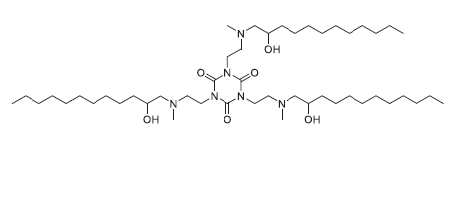
|
| DC80050 | LIPID A6 Featured |
Lipid A6 is an ionizable cationic and biodegradable alkyne lipid (pKa = 6.65).It has been used with other lipids in the formation of lipid nanoparticles (LNPs) for the delivery of mRNA. LNPs containing lipid A6 and encapsulating mRNA encoding human erythropoietin (EPO) increase and then maintain homeostatic levels of hemoglobin in the blood in an adenine-induced mouse model of renal anemia.
More description
|

|
| DC60489 | LIPID 331 Featured |
Lipid 331 is a biodegradable cyclic ionizable lipid. LNPs containing Lipid 331 result in robust transfection in the nasal and lung tissues of mice and efficient transfection of lung epithelial cells and lung-resident APCs. Lipid 331 is a promising candidate for mRNA vaccine delivery, offering the potential for further enhancing the potency of mRNA vaccines.
More description
|

|
| DC81110 | Lipid 202 (L202) Featured |
L202 is an ionizable lipid designed for mRNA vaccines, featuring a pH-responsive N-methylpiperidine head and a unique branched-tail structure with ester linkages to enable biodegradability. With a pKa of ~6.04–6.29, it facilitates efficient endosomal escape while maintaining stability in physiological conditions. Formulated into lipid nanoparticles (LNPs) of ~103 nm (PDI 0.08), L202 achieves >97% mRNA encapsulation efficiency. Its optimized structure drives robust immunogenicity: in mice, a single 0.1–10 μg dose induced dose-dependent SARS-CoV-2 spike-specific IgG titers, outperforming MC3-based LNPs and protein-alum vaccines. L202-LNPs elicited balanced Th1/Th2 responses (IgG2a/IgG1 ratio) and potent germinal center B cell activation, critical for durable immunity. Lyophilization with 16% sucrose preserved mRNA integrity and immunogenicity after 1-month storage at 5°C or 25°C, addressing cold-chain limitations. In nonhuman primates, two 100-μg doses generated neutralizing antibody titers exceeding convalescent human sera, with broad efficacy against Alpha, Beta, Gamma, and Delta variants. Rapid tissue clearance (72 hours post-injection) and minimal hepatic accumulation, attributed to ester hydrolysis, enhanced safety profiles. Additionally, L202-LNPs functioned as intrinsic adjuvants, amplifying protein vaccine responses. Combined with its lyophilization compatibility, potent cross-variant immunity, and favorable pharmacokinetics, L202 represents a promising platform for next-generation mRNA vaccines.
More description
|

|
| DC57006 | L319 Featured |
L319 (LIPID 319) is a novel ionizable, biodegradable lipid for delivery of short interfering RNAs (siRNAs). L319-LPN displays rapid elimination with pKa of 6.38 and also shows well tolerated up to 10 mg/kg.
More description
|

|
| DC82125 | lipid 14 Featured |
LIPID 14 is a novel ionizable lipid used for mRNA delivery.In 2021, Elia et al. used lipid 2 LNPs and lipid 14 LNPs to deliver mRNA encoding SARSCoV-2 human Fc-conjugated receptor binding domain (RBDhFc
mRNA). While both lipid 274 LNP RBD-hFc mRNA and
lipid 14 LNP RBD-hFc mRNA induced equal cellular and
humoral responses in mice at an mRNA dose of 5 μg, only lipid
14 LNP RBD-hFc mRNA exhibited strong immunogenicity
following intradermal administration. Both intradermal administration
and intramuscular administration of lipid 14 LNPs
could activate antigen presenting cells (APCs), thus inducing
cellular responses.
More description
|

|
| DC59002 | ssPalmO-Phe(SS-OP) Featured |
ssPalmO-Phe(SS-OP) is a self-degradable material for the delivery of oligonucleotides. ssPalmO-Phe is a self-degradable derivative of ssPalm that is self-degraded in the intraparticle space by a specific hydrolytic reaction. ssPalmO-Phe is beneficial for overcoming the plasma/endosomal membrane, LNP-ssPalmO-Phe can be used to deliver both nucleic acids.
More description
|

|
| DC80071 | A18-ISO5-2DC18 (Pimidol) Featured |
A18-Iso5-2DC18 that could not only deliver mRNA vaccines robustly but also activate the stimulator
of interferon genes (STING) pathway. A18-Iso5-2DC18 strongly binds to the stimulator of interferon genes (STING) and induces potent cytolytic T lymphocyte responses, resulting in substantial antitumor immunity (Miao et al. 2019).
More description
|
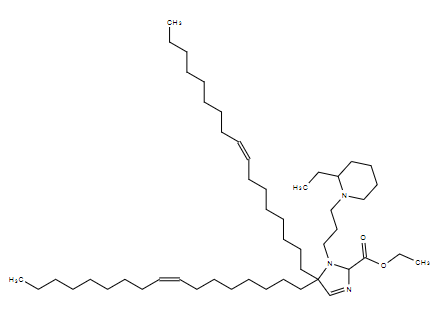
|
| DC82003 | A12-Iso5-2DC18 |
A12-Iso5-2DC18 is a novel amine containing lipid can be used for mRNA delivery, activate the stimulator of interferon genes (STING) pathway, and exhibit anti-tumor immunity.
More description
|

|
| DC53130 | 93-O17S Featured |
93-O17S is an imidazole-based synthetic lipidoid for in vivo mRNA delivery. Lipid nanoparticles (LNPs) with 93-O17S promotes both the cross-presentation of tumor antigens and the intracellular delivery of cGAMP (STING agonist).
More description
|

|
| DC80072 | 306-O12B (Triscormin) Featured |
306-O12B is a cationic lipidoid.306-O12B LNP is more efficient than MC-3 LNP in inducing loss-of-function mutations in Angptl3 through CRISPR-Cas9-based genome editing. It has been used in the generation of lipid nanoparticles (LNPs). Intravenous administration of LNPs containing 306-O12B and encapsulating an mRNA reporter accumulate specifically in the mouse liver. LNPs containing 306-O12B and encapsulating mRNA encoding the Cas9 nuclease (mCas9) and single-guide RNA targeting Angptl3 (sgAngptl3), the gene encoding angiopoietin-related protein 3, have been used to induce CRISPR-mediated gene knockdown in mice resulting in a reduction of serum Angptl3 protein, LDL, and triglyceride levels. A novel ionizable lipids library was constructed by a combinatory solvent-free Michael addition reaction between disulfide bondincorporated acrylate lipid tails and amine-containing heads. In this library, the tail-branched bioreducible ionizable lipid 306-O12B was screened out. Due to the presence of special ester bonds and branches in lipid tails, the accumulation of iLNPs in the liver was increased, and endosome escape was prompted. These iLNPs were used to deliver CRISPR-Cas9 mRNA and sgRNA targeting to angiopoietin-like 3 (Angptl3). Compared with FDA-approved MC3, 306-O12B induced more specific and efficient Angptl3 gene knockout in the liver, resulting in significant decrease in the levels of serum Angptl3 protein, low-density lipoprotein cholesterol (LDL-C), and triglyceride. According to the molecular shape hypothesis outlined several decades ago, the increase of branches can create ionizable lipids with more cone-shaped structure to enhance the destructiveness of the membrane structure of the endosome and increase mRNA release. However, it is unknown whether the structural stability of iLNPs will be sacrificed with the increase of branches. The optimal branches and chain length need to be further explored.
More description
|
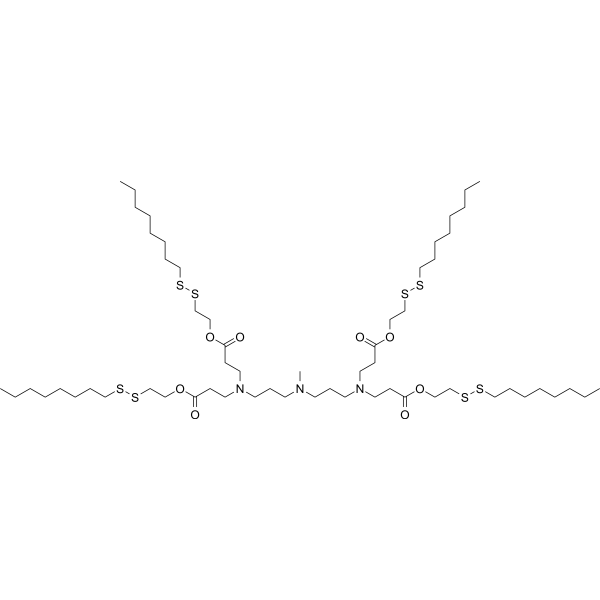
|
| DC82119 | 113-O16B Featured |
113-O16B is a disulfide bond-containing ionizable cationic lipidoid. It has been used in the generation of lipid nanoparticles (LNPs) for the delivery of mRNA.
More description
|
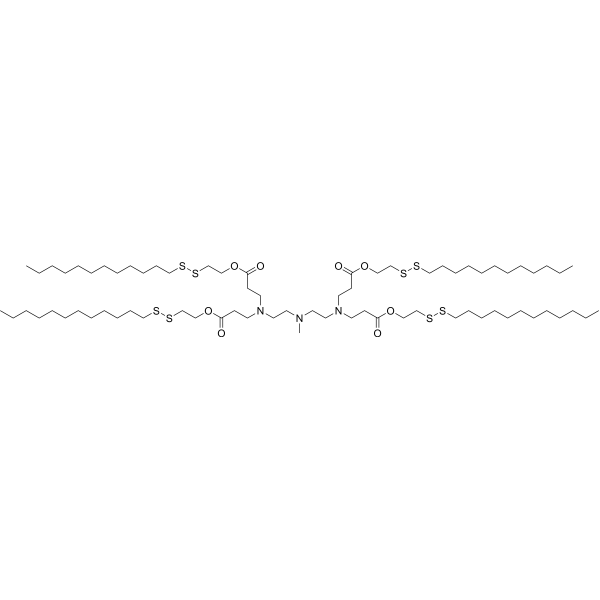
|
| DC82305 | 80-O16B Featured |
80-O16B is a disulfide bond-containing ionizable cationic lipidoid. It has been used in the generation of lipid nanoparticles (LNPs) for the delivery of CRISPR complementary single-guide RNA (sgRNA) and Cas9 for genome editing in mice. LNPs containing 80-O16B conjugated to phenylboronic acid (PBA) and encapsulating an mRNA reporter increase luciferase reporter expression in HeLa cancer cells.2 LNPs containing 80-O16B conjugated to PBA and encapsulating p53 mRNA decrease the viability of DU145 prostate and SiHa and HeLa cervical cancer cells.
More description
|
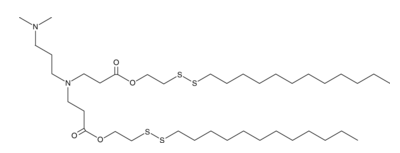
|
| DC82025 | 306-O12B-3 Featured |
306-O12B-3 is an ionizable lipidoid with cationic properties, commonly used in lipid nanoparticle (LNP) formulations for antisense oligonucleotide (ASO) delivery. When administered intravenously in mice, LNPs incorporating 306-O12B-3 exhibit liver-specific accumulation. Studies show that ASO-loaded LNPs containing 306-O12B-3 effectively silence hepatic PCSK9 expression by targeting the proprotein convertase subtilisin/kexin type 9 gene. Additionally, when combined with the cationic lipidoid NT1-O14B (Item No. 37095), these LNPs can deliver tau-targeting ASOs to the brain, reducing tau protein levels in mice.
More description
|
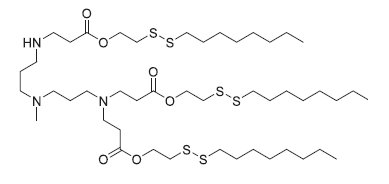
|
| DC82101 | AA3-DLin Featured |
AA3-DLin is an ionizable cationic amino lipid (pKa = 5.8) that has been used in combination with other lipids in the formation of lipid nanoparticles (LNPs) for the delivery of mRNA.LNPs containing AA3-DLin and encapsulating mRNA for the severe acute respiratory syndrome coronavirus 2 (SARS-CoV-2) spike glycoprotein induce immunogenicity in mice.
More description
|
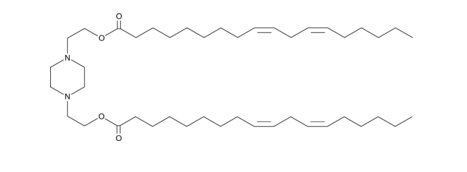
|
| DC71417 | YSK 05 Featured |
YSK 05 is a pH-sensitive cationic lipid. YSK 05 improves the intracellular trafficking of non-viral vectors. YSK 05-MEND shows significantly good gene silencing activity and hemolytic activity. YSK 05 overcomes the suppression of endosomal escape by PEGylation. YSK 05 effectively enhances siRNA delivery both in vitro and in vivo.
More description
|

|
| DC83220 | ALC-0315 analogous-1 Featured |
ALC-0315 analogous-1 is a derivative of the ionizable cationic amino lipid ALC-0315. It has been used in the synthesis of ionizable cationic lipids used in the generation of lipid nanoparticles (LNPs).
More description
|
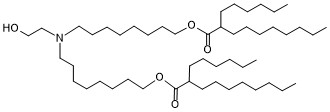
|
| DC65349 | ALC-0315 analgous-3 Featured |
ALC-0315 analgous-3 is an butanolamine ionizable lipid with both ester bonds located adjacent to C8 relative to the amine head. The introduction of ester linkages can improve the clearance of the lipid in the liver. This compound is analgous to ALC-0315.
More description
|

|
| DC65334 | Lipid 15 Featured |
Lipid 15 is an ionizable amino lipid used for the generation of Lipid nanoparticles .
More description
|

|
| DC65329 | ALC-0315 analogue-2 Featured |
ALC-0315 analogue-2 is an analogue of ALC-0315. ALC-0315 is an ionisable aminolipid that is responsible for mRNA compaction and aids mRNA cellular delivery and its cytoplasmic release through suspected endosomal destabilization. ALC-0315 can be used to form lipid nanoparticle (LNP) delivery vehicles. Lipid-Nanoparticles have been used in the research of mRNA COVID-19 vaccine.
More description
|
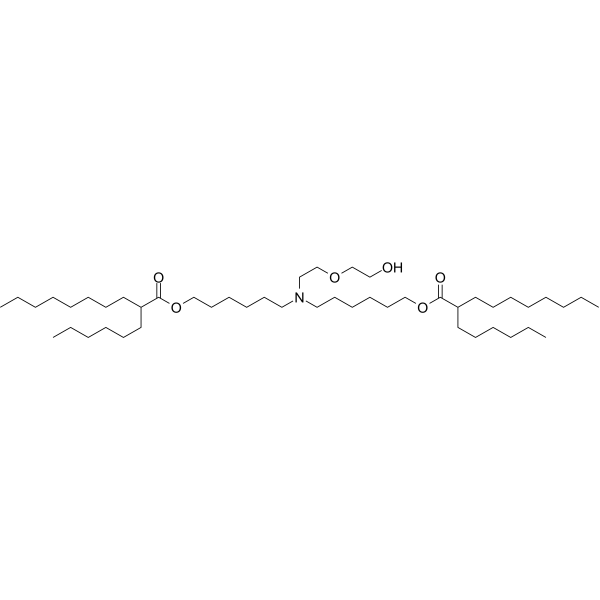
|
| DC65434 | SM102 Analog 1 Featured |
An analog of SM-102. The ethanolamine amino lipid head enhances encapsulation of mRNA. The lipid has primary esters at C7 position relative to the amine nitrogen. The primary lipid tail has 8 carbon tail. The lipid can be used for mRNA-based therapies which depends on the availability of a safe and efficient delivery vehicle.
More description
|

|